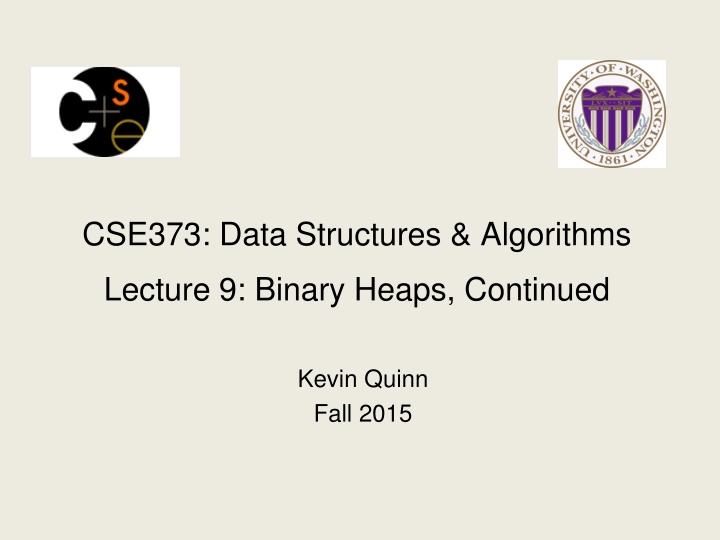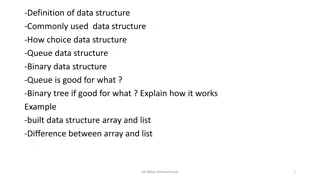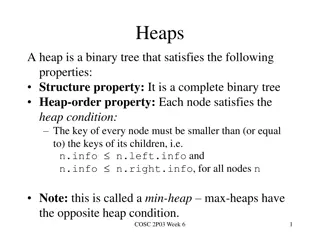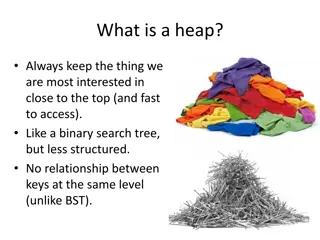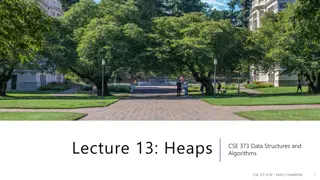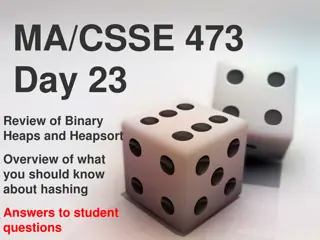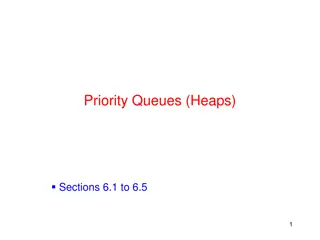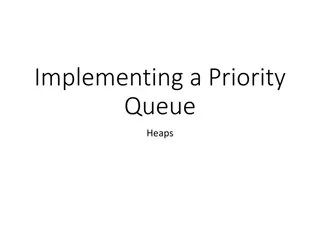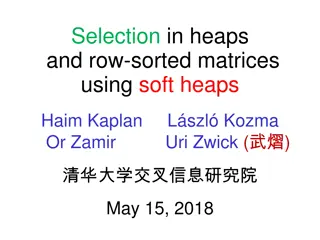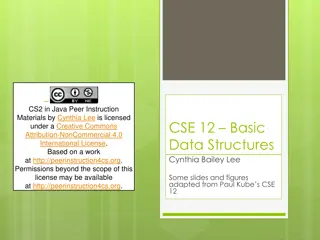Binary Heaps and Priority Queues in Data Structures
This content delves into the concepts of binary heaps and priority queues, explaining their implementations and operations. It discusses the array representation of binary trees and evaluates the array implementation in terms of space efficiency. The lectures explore various types of heaps such as Brodal heap, binomial heap, and Fibonacci heap, providing insights into their complexities and practicality. Additionally, it highlights the efficiency of binary heaps for priority queue operations like insert and deleteMin.
Uploaded on Feb 25, 2025 | 0 Views
Download Presentation

Please find below an Image/Link to download the presentation.
The content on the website is provided AS IS for your information and personal use only. It may not be sold, licensed, or shared on other websites without obtaining consent from the author.If you encounter any issues during the download, it is possible that the publisher has removed the file from their server.
You are allowed to download the files provided on this website for personal or commercial use, subject to the condition that they are used lawfully. All files are the property of their respective owners.
The content on the website is provided AS IS for your information and personal use only. It may not be sold, licensed, or shared on other websites without obtaining consent from the author.
E N D
Presentation Transcript
CSE373: Data Structures & Algorithms Lecture 9: Binary Heaps, Continued Kevin Quinn Fall 2015
Priority Queue ADT Brodal Heap Binomial Heap "quite complicated" and "[not] applicable in practice. -Gerth Brodal Paring Heap Fibonacci Heap Binary Heap A priority queue is just an abstraction for an ordered queue. A binaryheap is a simple and concrete implementation of a priority queue It s just one of many possible implementations! Fall 2015 CSE373: Data Structures & Algorithms 2
Review 10 6 2 23 15 12 18 45 3 7 20 80 insert deleteMin 40 60 85 99 700 50 Priority Queue ADT: insert comparable object, deleteMin Binary heap data structure: Complete binary tree where each node has priority value greater than its parent O(height-of-tree) = O(logn) insert and deleteMin operations insert: put at new last position in tree and percolate-up deleteMin: remove root, put last element at root and percolate-down But: tracking the last position is painful and we can do better Fall 2015 CSE373: Data Structures & Algorithms 3
Array Representation of Binary Trees Starting at node i 1 A left child: i*2 right child:i*2+1 parent: i/2 2 3 B C 6 7 4 5 F G D 9 E 11 8 10 12 H I J K L (wasting index 0 is convenient for the index arithmetic) implicit (array) implementation: A 1 B 2 C 3 D 4 E 5 F 6 G 7 H 8 I 9 J 10 K 11 L 12 0 13 parent i = 4 left right Fall 2015 CSE373: Data Structures & Algorithms 4
http://xkcd.com/163 Fall 2015 CSE373: Data Structures & Algorithms 5
Judging the array implementation Positives: Non-data space is minimized: just index 0 and unused space on right In conventional tree representation, one edge per node (except for root), so n-1 wasted space (like linked lists) Array would waste more space if tree were not complete Multiplying and dividing by 2 is very fast (shift operations in hardware) Last used position is just index size Negatives: Same might-by-empty or might-get-full problems we saw with stacks and queues (resize by doubling as necessary) Plusses outweigh minuses: this is how people do it Fall 2015 CSE373: Data Structures & Algorithms 6
Pseudocode: insert void insert(int val) { if(size == arr.length-1) resize(); size++; i=percolateUp(size,val); arr[i] = val; } int percolateUp(int hole,int val) { while(hole > 1 && val < arr[hole/2]) arr[hole] = arr[hole/2]; hole = hole / 2; } return hole; } 10 This pseudocode uses ints. In real use, you will have data nodes with priorities. 20 80 40 60 85 99 700 50 10 1 20 2 80 3 40 4 60 5 85 6 99 7 700 8 50 9 0 10 11 12 13 Fall 2015 CSE373: Data Structures & Algorithms 7
This pseudocode uses ints. In real use, you will have data nodes with priorities. Pseudocode: deleteMin int percolateDown(int hole,int val){ while(2*hole <= size) { left = 2*hole; right = left + 1; if(arr[left] < arr[right] || right > size) target = left; else target = right; if(arr[target] < val) { arr[hole] = arr[target]; hole = target; } else break; } return hole; } int deleteMin() { if(isEmpty()) throw ans = arr[1]; hole = percolateDown (1,arr[size]); arr[hole] = arr[size]; size--; return ans; } 10 20 80 40 60 85 99 700 50 10 1 20 2 80 3 40 4 60 5 85 6 99 7 700 8 50 9 0 10 11 12 13 Fall 2015 CSE373: Data Structures & Algorithms 8
Example insert: 16, 32, 4, 69, 105, 43, 2 deleteMin 1. 2. 0 1 2 3 4 5 6 7 Fall 2015 CSE373: Data Structures & Algorithms 9
Example insert: 16, 32, 4, 69, 105, 43, 2 deleteMin 1. 2. 16 1 0 2 3 4 5 6 7 16 Fall 2015 CSE373: Data Structures & Algorithms 10
Example insert: 16, 32, 4, 69, 105, 43, 2 deleteMin 1. 2. 16 1 32 2 0 3 4 5 6 7 16 32 Fall 2015 CSE373: Data Structures & Algorithms 11
Example insert: 16, 32, 4, 69, 105, 43, 2 deleteMin 1. 2. 4 1 32 2 16 3 0 4 5 6 7 4 32 16 Fall 2015 CSE373: Data Structures & Algorithms 12
Example insert: 16, 32, 4, 69, 105, 43, 2 deleteMin 1. 2. 4 1 32 2 16 3 69 4 0 5 6 7 4 32 16 69 Fall 2015 CSE373: Data Structures & Algorithms 13
Example insert: 16, 32, 4, 69, 105, 43, 2 deleteMin 1. 2. 4 1 32 2 16 3 69 4 105 5 0 6 7 4 32 16 69 105 Fall 2015 CSE373: Data Structures & Algorithms 14
Example insert: 16, 32, 4, 69, 105, 43, 2 deleteMin 1. 2. 4 1 32 2 16 3 69 4 105 5 43 6 0 7 4 32 16 69 105 43 Fall 2015 CSE373: Data Structures & Algorithms 15
Example insert: 16, 32, 4, 69, 105, 43, 2 deleteMin 1. 2. 2 1 32 2 4 3 69 4 105 5 43 6 16 7 0 2 32 4 69 105 43 16 Fall 2015 CSE373: Data Structures & Algorithms 16
Other operations decreaseKey: given pointer to object in priority queue (e.g., its array index), lower its priority value. Remember lower priority value is *better* (higher in tree). Change priority and percolate up increaseKey: given pointer to object in priority queue (e.g., its array index), raise its priority value. Change priority and percolate down remove: given pointer to object in priority queue (e.g., its array index), remove it from the queue. Percolate up to top and removeMin Running time for all these operations? Fall 2015 CSE373: Data Structures & Algorithms 17
Build Heap Suppose you have n items to put in a new (empty) priority queue Call this operation buildHeap n distinct inserts works (slowly) Only choice if ADT doesn t provide buildHeap explicitly O(nlogn) Why would an ADT provide this unnecessary operation? Convenience Efficiency: an O(n) algorithm called Floyd s Method Common issue in ADT design: how many specialized operations Fall 2015 CSE373: Data Structures & Algorithms 18
Floyds Method 1. Use n items to make any complete tree you want That is, put them in array indices 1, ,n 2. Treat it as a heap and fix the heap-order property Bottom-up: leaves are already in heap order, work up toward the root one level at a time void buildHeap() { for(i = size/2; i>0; i--) { val = arr[i]; hole = percolateDown(i,val); arr[hole] = val; } } Fall 2015 CSE373: Data Structures & Algorithms 19
Example In tree form for readability Purple for node not less than descendants heap-order problem Notice no leaves are purple Check/fix each non-leaf bottom-up (6 steps here) 12 5 11 3 10 2 9 4 8 1 7 6 Fall 2015 CSE373: Data Structures & Algorithms 20
Example Step 1 12 12 5 11 5 11 3 10 2 9 3 10 2 9 4 8 1 7 6 4 8 1 7 6 Happens to already be less than children (er, child) Fall 2015 CSE373: Data Structures & Algorithms 21
Example Step 2 12 12 5 11 5 11 3 10 2 9 3 1 2 9 4 8 1 7 6 4 8 10 7 6 Percolate down (notice that moves 1 up) Fall 2015 CSE373: Data Structures & Algorithms 22
Example Step 3 12 12 5 11 5 11 3 1 2 9 3 1 2 9 4 8 10 7 6 4 8 10 7 6 Another nothing-to-do step Fall 2015 CSE373: Data Structures & Algorithms 23
Example Step 4 12 12 5 11 5 2 3 1 2 9 3 1 6 9 4 8 10 7 6 4 8 10 7 11 Percolate down as necessary (steps 4a and 4b) Fall 2015 CSE373: Data Structures & Algorithms 24
Example Step 5 12 12 5 2 1 2 3 1 6 9 3 5 6 9 4 8 10 7 11 4 8 10 7 11 Fall 2015 CSE373: Data Structures & Algorithms 25
Example Step 6 12 1 1 2 3 2 3 5 6 9 4 5 6 9 4 8 10 7 11 12 8 10 7 11 Fall 2015 CSE373: Data Structures & Algorithms 26
But is it right? Seems to work Let s prove it restores the heap property (correctness) Then let s prove its running time (efficiency) void buildHeap() { for(i = size/2; i>0; i--) { val = arr[i]; hole = percolateDown(i,val); arr[hole] = val; } } Fall 2015 CSE373: Data Structures & Algorithms 27
Correctness void buildHeap() { for(i = size/2; i>0; i--) { val = arr[i]; hole = percolateDown(i,val); arr[hole] = val; } } Loop Invariant: For all j>i, arr[j] is less than its children True initially: If j > size/2, then j is a leaf Otherwise its left child would be at position > size True after one more iteration: loop body and percolateDown make arr[i] less than children without breaking the property for any descendants So after the loop finishes, all nodes are less than their children Fall 2015 CSE373: Data Structures & Algorithms 28
Efficiency void buildHeap() { for(i = size/2; i>0; i--) { val = arr[i]; hole = percolateDown(i,val); arr[hole] = val; } } Easy argument: buildHeap is O(nlogn) where n is size size/2 loop iterations Each iteration does one percolateDown, each is O(logn) This is correct, but there is a more precise ( tighter ) analysis of the algorithm Fall 2015 CSE373: Data Structures & Algorithms 29
Efficiency void buildHeap() { for(i = size/2; i>0; i--) { val = arr[i]; hole = percolateDown(i,val); arr[hole] = val; } } Better argument: buildHeap is O(n) where n is size size/2 total loop iterations: O(n) 1/2 the loop iterations percolate at most 1 step 1/4 the loop iterations percolate at most 2 steps 1/8 the loop iterations percolate at most 3 steps ((1/2) + (2/4) + (3/8) + (4/16) + (5/32) + ) < 2 (page 4 of Weiss) So at most 2(size/2)total percolate steps: O(n) Fall 2015 CSE373: Data Structures & Algorithms 30
Lessons from buildHeap Without buildHeap, our ADT already let clients implement their own in O(nlogn) worst case Worst case is inserting better priority values later By providing a specialized operation internal to the data structure (with access to the internal data), we can do O(n) worst case Intuition: Most data is near a leaf, so better to percolate down Can analyze this algorithm for: Correctness: Non-trivial inductive proof using loop invariant Efficiency: First analysis easily proved it was O(nlogn) Tighter analysis shows same algorithm is O(n) Fall 2015 CSE373: Data Structures & Algorithms 31
What we are skipping merge: given two priority queues, make one priority queue How might you merge binary heaps: If one heap is much smaller than the other? If both are about the same size? Different pointer-based data structures for priority queues support logarithmic time merge operation (impossible with binary heaps) Leftist heaps, skew heaps, binomial queues Worse constant factors Trade-offs! Fall 2015 CSE373: Data Structures & Algorithms 32
